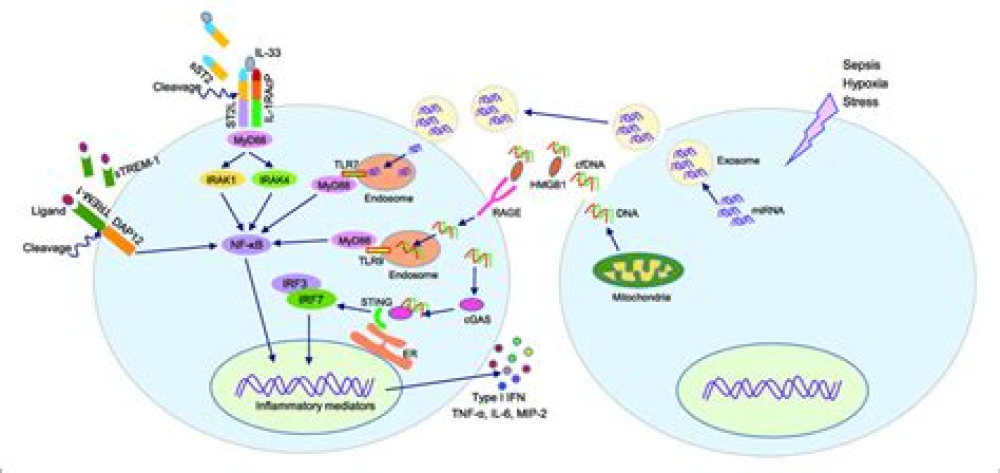- Review Article; Published:
Authors: Walter Gottlieb Land Genes & Immunity volume 22, pages141–160 (2021 )Cite this article
Abstract
When surveying the current literature on COVID-19, the “cytokine storm” is considered to be pathogenetically involved in its severe outcomes such as acute respiratory distress syndrome, systemic inflammatory response syndrome, and eventually multiple organ failure. In this review, the similar role of DAMPs is addressed, that is, of those molecules, which operate upstream of the inflammatory pathway by activating those cells, which ultimately release the cytokines. Given the still limited reports on their role in COVID-19, the emerging topic is extended to respiratory viral infections with focus on influenza. At first, a brief introduction is given on the function of various classes of activating DAMPs and counterbalancing suppressing DAMPs (SAMPs) in initiating controlled inflammation-promoting and inflammation-resolving defense responses upon infectious and sterile insults. It is stressed that the excessive emission of DAMPs upon severe injury uncovers their fateful property in triggering dysregulated life-threatening hyperinflammatory responses. Such a scenario may happen when the viral load is too high, for example, in the respiratory tract, “forcing” many virus-infected host cells to decide to commit “suicidal” regulated cell death (e.g., necroptosis, pyroptosis) associated with release of large amounts of DAMPs: an important topic of this review. Ironically, although the aim of this “suicidal” cell death is to save and restore organismal homeostasis, the intrinsic release of excessive amounts of DAMPs leads to those dysregulated hyperinflammatory responses—as typically involved in the pathogenesis of acute respiratory distress syndrome and systemic inflammatory response syndrome in respiratory viral infections. Consequently, as briefly outlined in this review, these molecules can be considered valuable diagnostic and prognostic biomarkers to monitor and evaluate the course of the viral disorder, in particular, to grasp the eventual transition precociously from a controlled defense response as observed in mild/moderate cases to a dysregulated life-threatening hyperinflammatory response as seen, for example, in severe/fatal COVID-19. Moreover, the pathogenetic involvement of these molecules qualifies them as relevant future therapeutic targets to prevent severe/ fatal outcomes. Finally, a theory is presented proposing that the superimposition of coronavirus-induced DAMPs with non-virus-induced DAMPs from other origins such as air pollution or high age may contribute to severe and fatal courses of coronavirus pneumonia.
Introduction
When the first articles on severe and fatal outcomes of COVID-19 were published, researchers worldwide working in the field of damage-associated molecular patterns (DAMPs) thought spontaneously: this is the work of DAMPs! And the researchers were surprised that most authors focused on the pathogenetic role of the “cytokine storm” observed in patients developing viral pneumonia-induced acute respiratory distress syndrome (ARDS) without discussing the fundamental part of DAMPs in initiating cytokine production. However, quite admittedly, the dataset on the pathogenetic role of DAMPs in COVID-19 is still too poor to prove their vital pathogenetic role in this challenging disease. On the other hand, there is accumulating evidence indicating that DAMPs are involved in respiratory viral disorders (as in all infectious diseases), culminating in three recent reports on their detection in COVID-19 patients [1,2,3]. This should be reason enough for a short review.
DAMPs in infectious diseases at a glance
The danger/injury model in Immunology, proposed in 1994 [4, 5] and after that several times modified, argues that immune responses are driven by cell stress and tissue injury, including pathogen-caused stress and injury, rather than by the recognition of non-self molecules derived, for example, from pathogenic invaders. The core of this model refers to the generation and emission of DAMPs, that is, molecules that are generated, exposed, or emitted upon any stress, damage, or death of cells.
For More Information: https://www.nature.com/articles/s41435-021-00140-w
